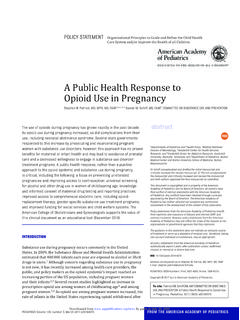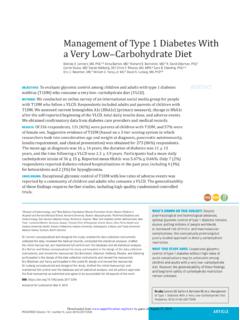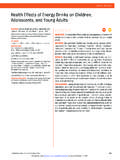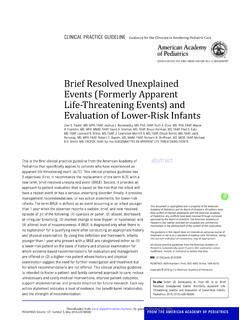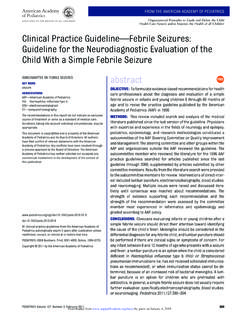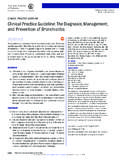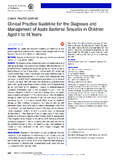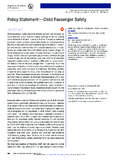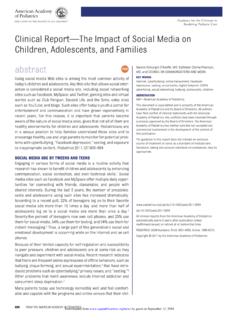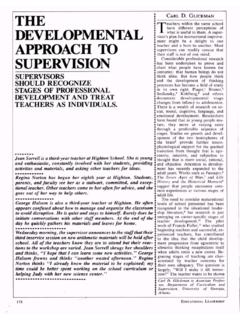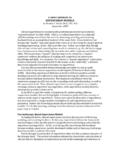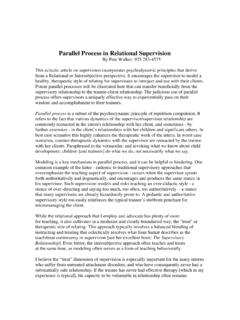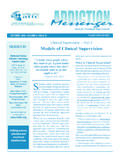Transcription of Guidance for the Clinician in Rendering Pediatric …
1 FROM THE AMERICAN ACADEMY OF PEDIATRICS. Guidance for the Clinician in Rendering Pediatric Care Clinical Report Health supervision for Children With Down Syndrome Marilyn J. Bull, MD, and the COMMITTEE ON GENETICS. ABBREVIATIONS abstract BAER brainstem auditory evoked response TSH thyroid-stimulating hormone These guidelines are designed to assist the pediatrician in caring for CRP C-reactive protein the child in whom a diagnosis of Down syndrome has been con rmed This document is copyrighted and is property of the American by chromosome analysis. Although a pediatrician's initial contact with Academy of Pediatrics and its Board of Directors. All authors the child is usually during infancy, occasionally the pregnant woman have led con ict of interest statements with the American who has been given a prenatal diagnosis of Down syndrome will be Academy of Pediatrics.
2 Any con icts have been resolved through a process approved by the Board of Directors. The American referred for review of the condition and the genetic counseling pro- Academy of Pediatrics has neither solicited nor accepted any vided. Therefore, this report offers Guidance for this situation as well. commercial involvement in the development of the content of Pediatrics 2011;128:393 406. this publication. The Guidance in this report does not indicate an exclusive INTRODUCTION. course of treatment or serve as a standard of medical care. Variations, taking into account individual circumstances, may be Children with Down syndrome have multiple malformations, medical appropriate. conditions, and cognitive impairment because of the presence of extra genetic material from chromosome ,2 Although the phenotype is variable, there typically are multiple features that enable the experi- enced Clinician to suspect the diagnosis.
3 Among the more common physical ndings are hypotonia, small brachycephalic head, epicanthal folds, at nasal bridge, upward-slanting palpebral ssures, Brush eld spots, small mouth, small ears, excessive skin at the nape of the neck, single transverse palmar crease, and short fth nger with clinodac- tyly and wide spacing, often with a deep plantar groove between the rst and second toes. The degree of cognitive impairment is variable and may be mild (IQ of 50 70), moderate (IQ of 35 50), or occasionally severe (IQ of 20 35). There is a signi cant risk of hearing loss (75%);. All clinical reports from the American Academy of Pediatrics obstructive sleep apnea (50% 79%); otitis media (50% 70%); eye dis- automatically expire 5 years after publication unless reaf rmed, ease (60%), including cataracts (15%) and severe refractive errors revised, or retired at or before that time.
4 (50%); congenital heart defects (50%); neurologic dysfunction (1% . PEDIATRICS (ISSN Numbers: Print, 0031-4005; Online, 1098-4275). 13%); gastrointestinal atresias (12%); hip dislocation (6%); thyroid Copyright 2011 by the American Academy of Pediatrics disease (4% 18%)3 6; and, less commonly, transient myeloproliferative disorder (4% 10%) and later leukemia (1%) and Hirschsprung disease ( 1%) (Table 1). The social quotient may be improved with early- intervention techniques, although the level of function is exceedingly variable. Children with Down syndrome often function more effectively in social situations than would be predicted on the basis of cognitive assessment results. In approximately 95% of children with Down syndrome, the condition is sporadic because of nonfamilial trisomy 21, in which there are 47.
5 Chromosomes with a free extra chromosome 21 being present. In ap- proximately 3% to 4% of persons with the Down syndrome phenotype, the extra chromosomal material is the result of an unbalanced trans- location between chromosome 21 and another acrocentric chromo- some, usually chromosome 14. Approximately three-quarters of these PEDIATRICS Volume 128, Number 2, August 2011 393. Downloaded from by guest on May 1, 2018. TABLE 1 Medical Problems Common in Down syndrome and facilitate their transi- incorporates maternal age risk with Syndrome tion to adulthood. The following outline measurement of maternal serum hCG, Condition %. is designed to help the pediatrician unconjugated estriol, -fetoprotein Hearing problems 75. provide care for children with Down (AFP), and inhibin levels.
6 The detection Vision problems 60. Cataracts 15 syndrome and their families in the rate of Down syndrome by rst- Refractive errors 50 medical home. It is organized by the trimester screening is 82% to 87%, by Obstructive sleep apnea 50 75 issues that need to be addressed in second-trimester screening is 80%, Otitis media 50 70. Congenital heart disease 40 50 various age groups (see Appendix 1). and by combined rst- and second- Hypodontia and delayed dental eruption 23 Several areas require ongoing assess- trimester screening (referred to as in- Gastrointestinal atresias 12 tegrated screening) is approximately Thyroid disease 4 18. ment throughout childhood and Seizures 1 13 should be reviewed at every physician 95%. These screening tests are re- Hematologic problems visit and at least annually.
7 These areas ported to have a 5% false-positive Anemia 3. include: 12. Iron de ciency 10. Transient myeloproliferative disorder 10 personal support available to family; Pediatricians may be asked to counsel Leukemia 1 a family whose fetus has been identi- Celiac disease 5 participation in a family-centered ed with or is at increased risk of Atlantoaxial instability 1 2 medical home;. Autism 1 Down syndrome. In some settings, the Hirschsprung disease 1. age-speci c Down syndrome re- pediatrician may be the primary re- lated medical and developmental source for counseling. At other times, conditions; counseling may have been provided nancial and medical support pro- for the family by a certi ed genetic unbalanced translocations are de grams for which the child and fam- counselor, a clinical geneticist, obste- novo, and the remainder result from ily may be eligible; trician, or developmental-behavioral familial translocations.
8 If the child has injury and abuse prevention with pediatrician. In addition, parents may a translocation, a balanced transloca- special consideration of develop- have received information from a tion must be excluded in the parents. mental skills; and Down syndrome program, a national When there is a translocation in a par- Down syndrome organization, or an In- ent, additional familial studies and ge- nutrition and activity to maintain ap- ternet site. Because the pediatrician netic counseling should be provided. In propriate weight. often has a previous relationship with the remaining 1% to 2% of persons THE PRENATAL VISIT the family, he or she should be pre- with the Down syndrome phenotype, a pared to review this information and mix of 2 cell lines is present: one nor- The American College of Obstetricians assist in the decision-making process.
9 Mal and the other with trisomy 21. This and Gynecologists recommends that When asked, the pediatrician should condition is called mosaicism. Persons all pregnant women, regardless of discuss the following topics with the with mosaicism may be more mildly age, be offered the option of diagnostic family: affected than persons with complete testing for Down syndrome and consider trisomy 21 or translocation chromo- 1. The prenatal laboratory studies less invasive screening ,8. some 21, but this is not always the that lead to the diagnosis and any Screening options have improved signif- case, and their condition may include fetal imaging studies that have icantly with the introduction of rst- any of the associated medical prob- been or will be performed.
10 Trimester screening, which incorporates lems and be indistinguishable from tri- maternal age, nuchal translucency ul- 2. The mechanism for occurrence of the somy 21. Recurrence risks for families trasonography, and measurement of disorder in the fetus and the potential with an affected child depend on maternal serum human chorionic go- recurrence rate for the family as pro- many factors, and families bene t nadotropin ( -hCG) and pregnancy- vided by genetic counseling. from counseling by a clinical genetic associated plasma protein A (PAPP-A). 3. The prognosis and phenotypic man- professional. Second-trimester screening is available ifestations, including the wide Medical management, home environ- for patients who rst seek medical range of variability seen in infants ment, early intervention, education, care in the second trimester or in loca- and children with Down syndrome.
